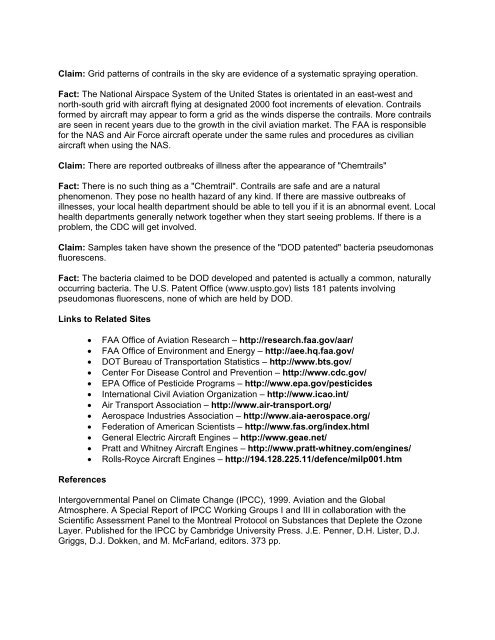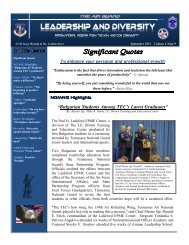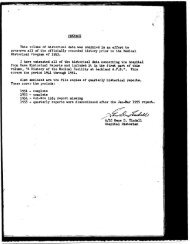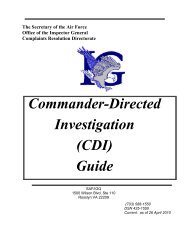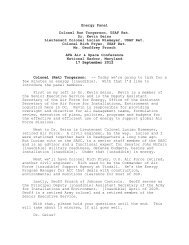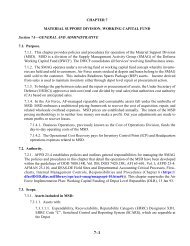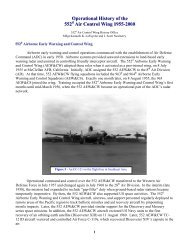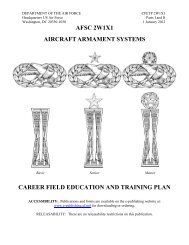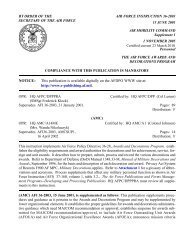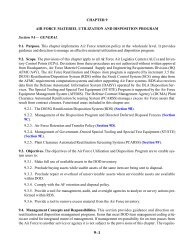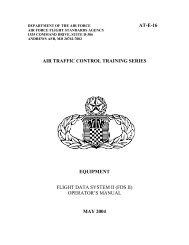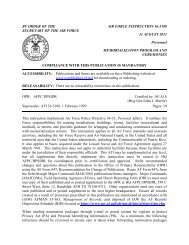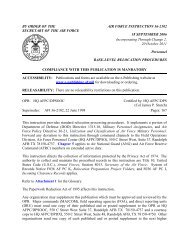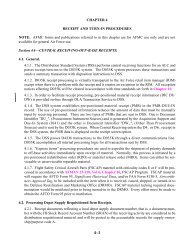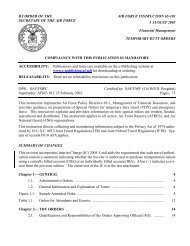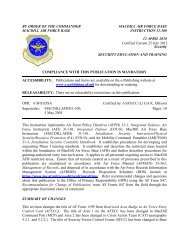CONTRAILS FACTS - Air Force Link
CONTRAILS FACTS - Air Force Link
CONTRAILS FACTS - Air Force Link
- TAGS
- contrails
- link
- www.af.mil
You also want an ePaper? Increase the reach of your titles
YUMPU automatically turns print PDFs into web optimized ePapers that Google loves.
Claim: Grid patterns of contrails in the sky are evidence of a systematic spraying operation.<br />
Fact: The National <strong>Air</strong>space System of the United States is orientated in an east-west and<br />
north-south grid with aircraft flying at designated 2000 foot increments of elevation. Contrails<br />
formed by aircraft may appear to form a grid as the winds disperse the contrails. More contrails<br />
are seen in recent years due to the growth in the civil aviation market. The FAA is responsible<br />
for the NAS and <strong>Air</strong> <strong>Force</strong> aircraft operate under the same rules and procedures as civilian<br />
aircraft when using the NAS.<br />
Claim: There are reported outbreaks of illness after the appearance of "Chemtrails"<br />
Fact: There is no such thing as a "Chemtrail". Contrails are safe and are a natural<br />
phenomenon. They pose no health hazard of any kind. If there are massive outbreaks of<br />
illnesses, your local health department should be able to tell you if it is an abnormal event. Local<br />
health departments generally network together when they start seeing problems. If there is a<br />
problem, the CDC will get involved.<br />
Claim: Samples taken have shown the presence of the "DOD patented" bacteria pseudomonas<br />
fluorescens.<br />
Fact: The bacteria claimed to be DOD developed and patented is actually a common, naturally<br />
occurring bacteria. The U.S. Patent Office (www.uspto.gov) lists 181 patents involving<br />
pseudomonas fluorescens, none of which are held by DOD.<br />
<strong>Link</strong>s to Related Sites<br />
References<br />
• FAA Office of Aviation Research – http://research.faa.gov/aar/<br />
• FAA Office of Environment and Energy – http://aee.hq.faa.gov/<br />
• DOT Bureau of Transportation Statistics – http://www.bts.gov/<br />
• Center For Disease Control and Prevention – http://www.cdc.gov/<br />
• EPA Office of Pesticide Programs – http://www.epa.gov/pesticides<br />
• International Civil Aviation Organization – http://www.icao.int/<br />
• <strong>Air</strong> Transport Association – http://www.air-transport.org/<br />
• Aerospace Industries Association – http://www.aia-aerospace.org/<br />
• Federation of American Scientists – http://www.fas.org/index.html<br />
• General Electric <strong>Air</strong>craft Engines – http://www.geae.net/<br />
• Pratt and Whitney <strong>Air</strong>craft Engines – http://www.pratt-whitney.com/engines/<br />
• Rolls-Royce <strong>Air</strong>craft Engines – http://194.128.225.11/defence/milp001.htm<br />
Intergovernmental Panel on Climate Change (IPCC), 1999. Aviation and the Global<br />
Atmosphere. A Special Report of IPCC Working Groups I and III in collaboration with the<br />
Scientific Assessment Panel to the Montreal Protocol on Substances that Deplete the Ozone<br />
Layer. Published for the IPCC by Cambridge University Press. J.E. Penner, D.H. Lister, D.J.<br />
Griggs, D.J. Dokken, and M. McFarland, editors. 373 pp.


